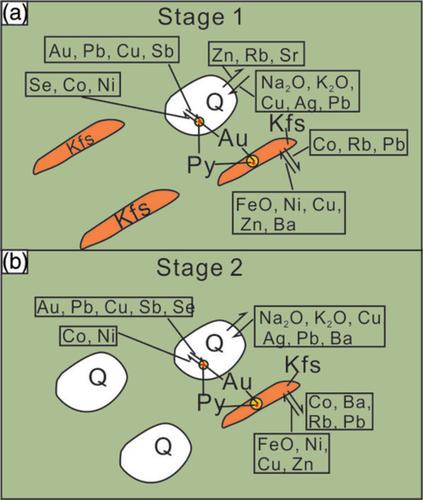当前位置:
X-MOL 学术
›
Geolog. J.
›
论文详情
Our official English website, www.x-mol.net, welcomes your feedback! (Note: you will need to create a separate account there.)
Hydrothermal alteration and mineralization of Baiyun gold deposit in Liaodong Peninsula, North China Craton
Geological Journal ( IF 1.8 ) Pub Date : 2020-12-22 , DOI: 10.1002/gj.4065 Zhichao Zhang 1 , Yuwang Wang 1 , Dedong Li 1 , Wei Wang 2 , Shenghui Li 2 , Jinzhu Qiu 2 , Chunkit Lai 3 , Xiang Li 4
Geological Journal ( IF 1.8 ) Pub Date : 2020-12-22 , DOI: 10.1002/gj.4065 Zhichao Zhang 1 , Yuwang Wang 1 , Dedong Li 1 , Wei Wang 2 , Shenghui Li 2 , Jinzhu Qiu 2 , Chunkit Lai 3 , Xiang Li 4
Affiliation

|
Baiyun deposit is a large gold deposit in the Liaodong Peninsula (North China Craton), containing over 31.7 t of gold. Silicic alteration, K‐feldspar alteration, and pyritization are well developed and closely related with mineralization in Baiyun deposit. Based on field and optical microscopic observations, the alteration styles include quartz + K‐feldspar zone, pyrite + sericite +quartz zone, and chlorite zone from orebody outward. In this study, the quartz, K‐feldspar, and pyrite of pre‐ore, syn‐ore stages 1 and 2 were selected for LA‐ICP‐MS trace element analysis and electron probe microanalysis (EPMA) to reveal the alteration‐mineralization link. Results show that the albite was altered to mainly K‐feldspar and minor secondary quartz at syn‐ore stage 1. Fluid‐rock reaction of the silicic‐potassic alteration may have decreased the fluid oxygen fugacity (fO2), which triggered the gold precipitation. Most of invisible gold occurred in the form of solid solution. At syn‐ore stage 2, albite altered to mainly quartz and minor K‐feldspar. The syn‐ore stage 1 K‐feldspar also altered to minor secondary quartz at syn‐ore stage 2. In addition, the release of sulphur from the syn‐ore stage 1 pyrite was likely another trigger for the gold precipitation. Most of syn‐ore stage 2 invisible gold occurred as nano‐particles. The ore‐forming fluids consist mainly of primary magmatic fluids mixed with minor metamorphic fluids. The ore metals may have sourced mainly from the magmatic fluid and the sillimanite‐mica schist of the Gaixian Formation.
中文翻译:

华北克拉通辽东半岛白云金矿床热液蚀变及成矿作用
白云矿床是辽东半岛(华北克拉通)的大型金矿床,含金量超过31.7吨。白云矿床的硅质蚀变,钾长石蚀变和黄铁矿化发展良好,与矿化关系密切。根据现场和光学显微镜观察,蚀变样式包括从矿体向外的石英+钾长石带,黄铁矿+绢云母+石英带和绿泥石带。在这项研究中,选择了矿石前,同步矿石阶段1和2的石英,钾长石和黄铁矿进行LA-ICP-MS痕量元素分析和电子探针微分析(EPMA),以揭示蚀变矿化联系。结果表明,在合成矿石第1阶段,钠长石主要转变为钾长石和次要石英。f O 2),这触发了金的沉淀。大部分看不见的金都以固溶体形式存在。在合成阶段2,钠长石主要转变为石英和次要的钾长石。同步矿阶段1的钾长石在同步矿阶段2也变成了次要的次生石英。此外,从同步矿阶段1的黄铁矿释放的硫很可能是金沉淀的另一个触发因素。处于同步矿石第2阶段的大部分不可见金都以纳米颗粒的形式出现。成矿流体主要由主要的岩浆流体与少量的变质流体混合而成。矿石金属可能主要来自盖县组的岩浆流体和硅线石-云母片岩。
更新日期:2020-12-22
中文翻译:

华北克拉通辽东半岛白云金矿床热液蚀变及成矿作用
白云矿床是辽东半岛(华北克拉通)的大型金矿床,含金量超过31.7吨。白云矿床的硅质蚀变,钾长石蚀变和黄铁矿化发展良好,与矿化关系密切。根据现场和光学显微镜观察,蚀变样式包括从矿体向外的石英+钾长石带,黄铁矿+绢云母+石英带和绿泥石带。在这项研究中,选择了矿石前,同步矿石阶段1和2的石英,钾长石和黄铁矿进行LA-ICP-MS痕量元素分析和电子探针微分析(EPMA),以揭示蚀变矿化联系。结果表明,在合成矿石第1阶段,钠长石主要转变为钾长石和次要石英。f O 2),这触发了金的沉淀。大部分看不见的金都以固溶体形式存在。在合成阶段2,钠长石主要转变为石英和次要的钾长石。同步矿阶段1的钾长石在同步矿阶段2也变成了次要的次生石英。此外,从同步矿阶段1的黄铁矿释放的硫很可能是金沉淀的另一个触发因素。处于同步矿石第2阶段的大部分不可见金都以纳米颗粒的形式出现。成矿流体主要由主要的岩浆流体与少量的变质流体混合而成。矿石金属可能主要来自盖县组的岩浆流体和硅线石-云母片岩。



























 京公网安备 11010802027423号
京公网安备 11010802027423号